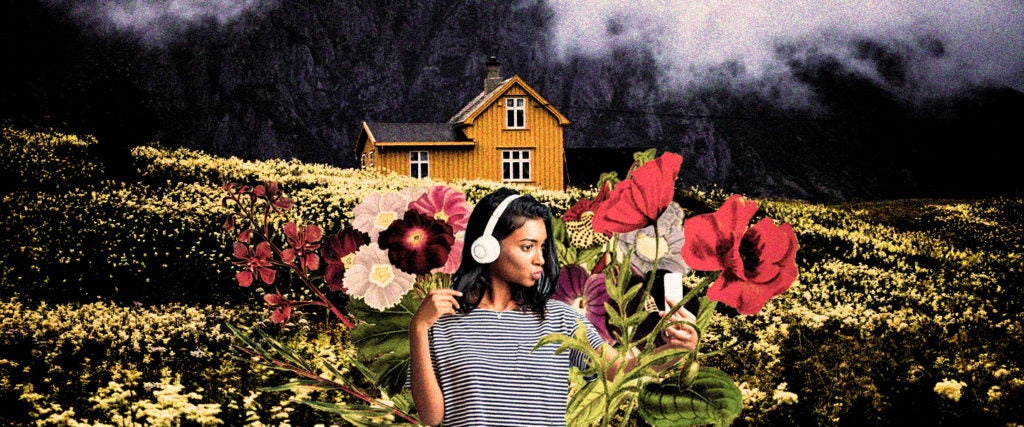Every weekday morning, Grace wakes up early, puts a kettle on the stove and shakes ground coffee into a French press. It’s time for her morning routine: First, she waters her plants, then it’s time to feed the chickens. She returns inside with three eggs wrapped inside newspaper, and greets her wife, who’s standing in the kitchen yawning and pushing the plunger on the French press. Grace cracks the eggs into a pan and starts chopping vegetables.
Grace lives in a beautiful cabin in the mountains of Western Colorado, painted pale yellow with pastel pink shutters. The paint is chipping around the edges of the wood, but she and her wife prefer it that way. Grace wiles away most of her day making rugs in the shed by her cabin. After she’s done working — in the late afternoon — she strips down to a raggedy T-shirt and underwear and throws on a Kate Bush record. Then, she and her wife practice yoga on the living room rug she made while a medley of vegetables roast in the oven. She’s totally at ease, and there isn’t a phone in sight.
At least, that’s the fantasy.
In reality, Grace is 21, single, “woefully unemployed” and living in Austin, Texas. The Colorado cabin of her dreams stands in stark contrast to her actual life, which Grace says is characterized by “remote learning and working, seven hours of TikTok and Twitter screen time, Amazon, Instagram, Netflix, food delivery and nothing to do but stare at Good and Bad screens all day.” She describes her cabin fantasy as “an escapist yearning to live a different life — like a societal blackpill, almost.”
By now, the fact that zoomers are into “cottagecore” — the name given to this dreamy, rural aesthetic-cum-aspiration — isn’t exactly news: Trend pieces were popping up as early as March, and Vox has already dubbed cottagecore the “standout aesthetic of 2020.” Big cottagecore accounts on TikTok, Tumblr and Instagram amass tens of thousands of followers, most of whom are zoomers living high-tech lives in urban areas, coveting a rural lifestyle replete with handcrafted fairy spoons and lavender-infused strawberry juice. And for plenty of people, quarantine has only intensified that yearning for a simple, domestic life.
Feeling like this quarantine has fast forwarded us sluts into our domestic era earlier than we anticipated pic.twitter.com/58FWVGozWe
— Babs Gray (@BabsGray) May 9, 2020
Meatballs for days! ?
Pandemic has me going domestic tenfold. I rarely eat out and everything is home made and made from scratch. ??
Also, I use cooking as an escape when I’m depressed or feeling down. pic.twitter.com/nWTGWSrK7b
— jaded (@jaded_ice) June 18, 2020
we nesting all quarantine y'all https://t.co/k79qjmMBHZ
— misery (@XOXOGOSSIPGOTH) May 15, 2020
Quarantine has me feeling ultra domestic. Lesbian trophy wife? My calling perhaps
— ✨Juniper Darling✨ (@motherjuniper) May 15, 2020
It’s not hard to see the appeal of the fantasy, and cottagecore zoomers are very self-aware about why this lifestyle exerts such a magnetic pull. In part, it’s all about unplugging from an anxiety-inducing, hyper-connected life, and returning to an imagined golden age where the pace was more sedate. “I think it has to do with the idea of slow values over fast values,” explains Declan, a 21-year-old student and cottagecore enthusiast in Illinois. “I’ve grown up in a time where everything is ‘fast’ — fast information, fast food, fast consumerism — so there’s something really idyllic about the idea of slowing things down, growing my own food, making my clothes and crafting with my hands.”
But it’s not just about disconnecting from ever-present screens, it’s also about dodging wider societal ills. Jessica, a 21-year-old student in New Jersey, says it’s about “escaping capitalism, and men, to live a cute humble life in the countryside,” and Martín, a 19-year-old student in Spain, thinks a self-contained, sustainable lifestyle represents freedom from “big billionaires controlling your life through monopolies and lobbying.” “In the U.S., the political climate seems pretty hopeless and dark,” Grace adds. “Young people, which have the biggest stake in the game but little to no voice, see cottagecore as this eco-friendly escapist fantasy from late-stage capitalism and climate change.”
Despite the outward similarity to a trad-wife lifestyle, the cottagecore community is full of people who identify as progressives. Criticism from within the community reckons with whether cottagecore has become dominated by a certain kind of white person — “a lot of the criticism I see is that the aesthetic is primarily skinny white women showing off their ‘humble’ lifestyles when that isn’t the full story of their material conditions,” Jessica says — and whether the aspiration to retreat to rural life encourages gentrification and romanticizes Western agriculture, with its history of throwing indigenous people off their land and exploiting immigrant labor. There are also internal debates about whether cottagecore dabbles in eco-fascism, or excludes fat women, or promotes an ideal of domesticity and femininity prized by white supremacists.
In response to these perceived problems, many of the cottagecore zoomers I speak to have developed a kind of moral vigilance. “I think if you’re into cottagecore you just have to be careful to avoid regurgitating white supremacist and conservative rhetoric in the guise of wanting a ‘peaceful rural lifestyle,’” Declan says, echoing others I speak to. “Those ideas can definitely be twisted into the same frameworks that cottagecore stems from.”
But some outside critics have pointed to what they see as a deeper problem with cottagecore, which is that this kind of off-the-grid escapism isn’t actually progressive at all. “It is in no sense a rational response to developed capitalism, which needs political solutions,” writes journalist Tanya Gold. “In any case, it makes no sense for women. A washing line is pretty, sometimes, but it is an aesthetic of powerlessness. … Women were once delighted not to be at the hen house, the mangle and the dairy. Modernity emancipated them from that, and they were grateful.”
Many of the zoomers I talk to have already grappled with these criticisms, and made peace with the contradictions of cottagecore. “It’s escapist in that it could be used to bury your head in the sand and ignore the problems we face as a society,” Declan explains. “If you’re off in your little cottage eating pastries, you may no longer feel the need to be politically active, act against climate change or improve your previous communities.” Grace adds that she sees cottagecore “as a reclamation or subversion of trad life,” and that “it’s relatively easy to take it out of its original context and reshape it into something something queer and feminist.”
The reason it’s easy for Grace and others to imagine a rural lifestyle that’s also impeccably progressive, queer and feminist is that, ultimately, none of this is real. Cottagecore is a fantasy of a disconnected life refracted entirely through social media to hyper-online teens, involving the aesthetics of home ownership for generations of young people who may never be able to afford a home of their own. As Gold notes, it’s “a lament for something they will never have, and the tragedy is that they know it.”
Which means that maybe all the hand-wringing about the politics of cottagecore is a slight waste of energy. “Honestly, repeating all of the weird leftist discourse around the aesthetic sounds bizarre right now,” Jessica admits. “I personally really enjoy the aesthetic, and I’ve seen plenty of women of color just enjoying themselves on picnics in pretty dresses, which is a bit of fresh air with the state of the world right now.”
“I don’t think it’s really more than a fantasy a lot of young people are yearning for,” she adds.

